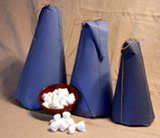Have you heard that early American settlers used the blue paper from sugar cones to dye their fabric?
I have! And why not? It was there from the sugar cone wrappers. Why just throw it away?
I found such a blue wrapped paper sugar cone on my visit to the Farm House at Washington on the Brazos Historical Site. The following article debunks the logic that Early American Settlers used this for dye--Read on!
A sweet story, but experts in historic crafts say that no actual instances of this practice are known in America’s colonial era. Apart from lack of evidence, it is illogical. Refined sugar was an expensive, imported luxury—think caviar—that only the wealthiest could afford. Not the sort who are scrimping and recycling their wrapping paper or dying their own fabric. (If the family budget couldn’t stretch to include sugar, what did folks back then use for sweeteners? Maple sugar, honey, molasses, or muscovado sugar. Or nothing.)
But lo and behold, several household management books published in the mid-nineteenth century do mention this practice. In one of them, The American Frugal Housewife (1835), author Lydia Childs tells how to make various cheap dyes, including “a fine purple slate color” by boiling sugar wrapping paper in vinegar with alum and boiling it in an iron kettle. In another, Eliza Leslie’sLady’s Frugal House-Book; a Manual of Domestic Economy(1850), the chapter on domestic dyes tells how to make a slate color by boiling vinegar and alum in an iron kettle with some pieces of “the thick purple paper that comes round sugar-loaves.”
Why then and not earlier? Probably because that’s when sugar became cheap. The expansion of Caribbean sugar plantations flooded the market with sugar and prices dropped, bringing sugar loaves, wrapped in traditional purplish-blue paper, within reach of most housewives. And the average housewife is just the sort who might be interested in learning to dye her own fabric on the cheap. So this myth is false when heard at early American sites and true for later, nineteenth-century sites.
Where did the purplish-blue paper custom, as opposed to white or brown or another color, originate? Probably in the Middle East or North Africa, where sugarcane cultivation originated. In certain North African countries, sugar is still sold that way in grocery stores, as large cones wrapped in blue paper. I saw them in a Moroccan grocery store a few years ago, and also in a market in Jordan.
/






No comments:
Post a Comment